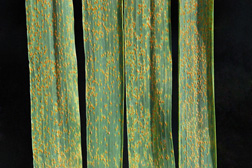This page has been archived and is being provided for reference purposes only. The page is no longer being updated, and therefore, links on the page may be invalid.
A Better Understanding of a Major Threat to Wheat
By Dennis O'BrienMay 5, 2009
The pathogen that causes the world's most common wheat disease is a moving target, but scientists are now better equipped to keep track of it, thanks to some genetic sleuthing by Agricultural Research Service (ARS) scientists.
Up to 60 resistance genes have been known to combat Puccinia triticina, the fungus that causes wheat leaf rust. But the pathogen is so genetically diverse and quick to adapt that most wheat resistance genes prove ineffective within a few years.
The stakes are high. Leaf rust is the world's most widely distributed wheat disease, and in Kansas alone wheat producers lost 14 percent of their crop--some 50 million bushels--to a leaf rust epidemic in 2007. Emerging strains of P. triticina are an increasing threat to soft red winter wheat in the southeastern United States, and to hard red winter wheat and hard red spring wheat in the Great Plains, according to James Kolmer, a plant pathologist at the ARS Cereal Disease Laboratory in St. Paul, Minn.
Kolmer recently completed a comprehensive genetic analysis of emerging strains of P. triticina collected in a recent survey of North America's major wheat-producing areas, probing the strains with DNA markers specifically developed for the leaf rust fungus and for virulence capable of overcoming wheat leaf rust resistance genes.
Kolmer found that the strains of P. triticina infecting wheat in North America fall into five genetically distinct groups, with two widely distributed groups accounting for 90 percent of the total population. The five groups also differ in their ability to overcome a number of resistance genes, an indication that different groups of P. triticina develop virulence traits at different rates.
The work, to be published in the journal Phytopathology, will help researchers identify the origins of emerging strains of P. triticina, unravel clues about migration patterns, monitor shifts in virulence and figure out why some resistance genes are more effective and long-lasting than others.
ARS is the principal intramural scientific research agency of the U.S. Department of Agriculture.

